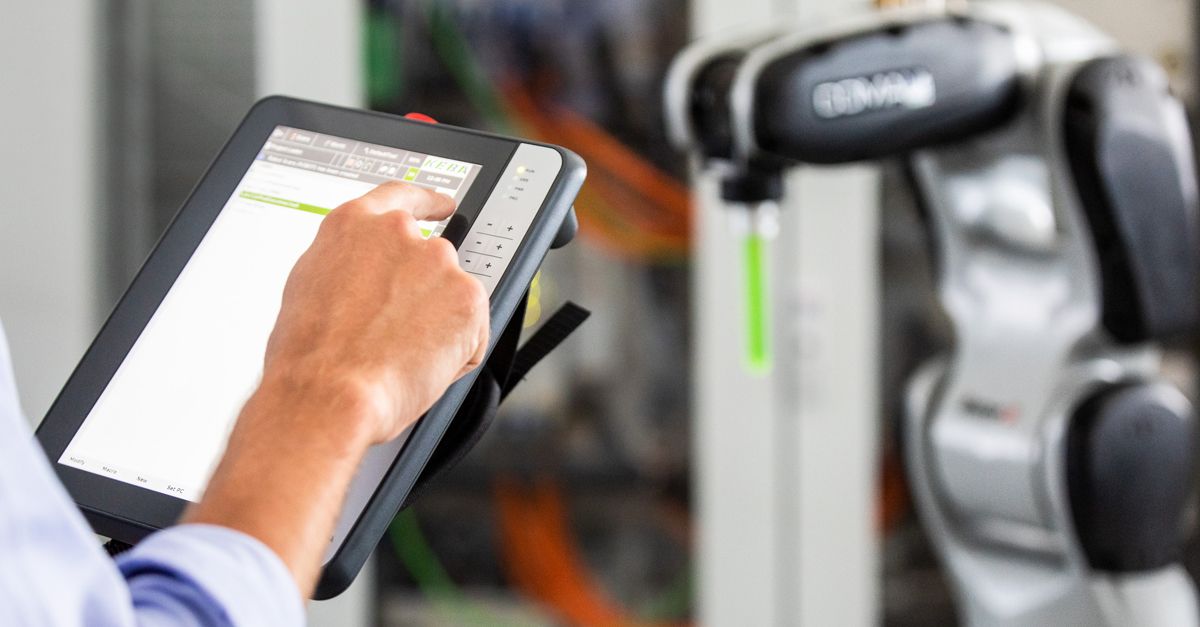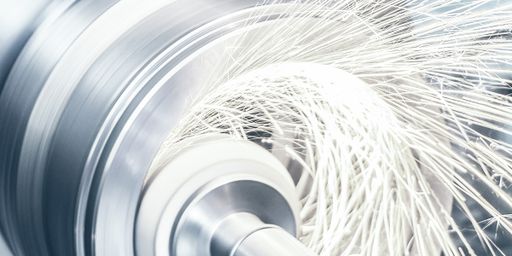10 reasons why industrial HMI devices are better than consumer devices
- HMI
- 8.11.2021
- Reading Time: 8 min
- Share Article

Contents
What are the main differences between an industrial HMI and a smartphone or a tablet?
1. An HMI device is much more robust than a smartphone
2. HMI devices meet the legal EMC requirements
3. An HMI device comes with all the relevant safety features
4. An HMI device guarantees a fast and secure transmission to the machine controller
5. HMI devices meet ergonomic standards
6. An HMI device allows “blind touch” operation
7. An HMI device guarantees availability and compatibility
8. An HMI device won’t overheat and fail
9. HMI devices meet the industrial security standards
Can you operate industrial machines with a smartphone or tablet?
What are the main differences between an industrial HMI and a smartphone or a tablet?
There is no large-scale use of smartphones or tablets in industrial settings so far, even though there are certainly some use cases where consumer devices can render valuable services in the production process (mainly among SMEs).
Nevertheless, industrial panels are still superior to consumer devices – and this is mainly due to the conditions under which these user interfaces are used.
Below, we list the main differences between smart devices and HMI devices, and ten good reasons why you should continue to rely on industrial HMI instead of smartphones or tablets.
1. An HMI device is much more robust than a smartphone
The operation device is one of the most important elements of any machine. If it fails, this typically affects the availability of the machine. Because without this most important interface between the human and the machine, the operator cannot take any readings, make any settings, monitor any processes, or switch anything off.
Availability on the whole is highly important, especially with a view to ruggedness. An industrial panel is a modern tool that can handle some rough treatment. It is guaranteed to remain functional even after being dropped on the floor.
Smartphones or tablets, by contrast, break easily from such an accident and then no longer work. This has the effect that the associated machine can no longer be operated, or only in a limited way, and may even shut down until the device has been repaired.
After all, for consumer devices – which are basically lifestyle products – looks and design are much more important than suitability for industrial conditions.
2. HMI devices meet the legal EMC requirements
For devices used in industrial settings, the requirements concerning EMC (electromagnetic compatibility) are much more stringent than for consumer devices. This is due primarily to the fact that excessive electromagnetic radiation can jeopardize the safety of people and machines.
For example, if using an operation device not adequately tested for an industrial setting (e. g. in a room full of production machines), unintended actions may be triggered on the screen and consequently on a machine. This could for example damage a workpiece.
Electromagnetic compatibility is governed by a corresponding Directive. Consumer devices typically do not meet the much more stringent EMC requirements. Therefore, their use in an industrial setting is not compliant with the standard.
3. An HMI device comes with all the relevant safety features
The Machinery Directive (chapter 1.2.4.3 requires machines and systems to have an emergency stop device that can eliminate hazards or reduce risks in an emergency.
Based on this Directive, there are certain requirements for safety features that are necessary for the operation of machinery. For this reason, industrial HMI devices come with safety features such as emergency stop, enabling devices or operating mode selectors.
Consumer devices do not have such safety features, making them rather unsuitable for moving actual machines or machine parts in a practical application.
One might be tempted to think, “OK, I’ll simply expand my smart device and add these safety features.” However, this leads to a massive overhead in design efforts and costs, and at the end of the day, one usually looks at an expensive “stopgap” solution.
The following standards include requirements for emergency stop features and manual operation devices:
- EN ISO 13850:2015 (Safety of machinery – emergency stop – principles for design)
- EN 60204-1:2018 (Safety of machinery – Electrical equipment of machines – Part 1: general requirements)
- EN ISO 10218-1:2011 (Robots and robotic devices – Safety requirements for industrial robots – Part 1: Robots)
Industrial panels must be clearly designed for continuous operation
4. An HMI device guarantees a fast and secure transmission to the machine controller
When pressing a button on an operation device, the important thing is not the response the user can see or feel on the device. Rather, the important thing is the response time of the machine – in other words, how long does it need to respond to the push of the button.
Using industrial operation devices ensures that this response registers in the machine controller within a precisely defined or even guaranteed maximum minimum time (a few milliseconds).
Both wired and wireless HMI devices come with a built-in proprietary software protocol that ensures fast transmission. If this fast transmission time is not guaranteed, there is the risk that machines or tools can be damaged by the overrun.
Smart devices can be assumed to be wireless and typically use Wi-Fi to connect to the machine controller. Aside from the bus conversion, it must be assumed that such a set-up involves significant latency in the range of seconds.
5. HMI devices meet ergonomic standards
In order to minimize the physical strain that users are subjected to, machines and their operator stands must meet certain ergonomic standards.
Industrial panels, for example, must be clearly designed for continuous operation. The operator must be able to operate the device for an entire working day (one shift) without becoming fatigued.
This means that the operation panel must be very comfortable to use. Working with an unergonomic device – for example one that feels too heavy – increases the error susceptibility, which then causes the user efficiency to drop. The result is a preventable increase in costs.
The ergonomic standards for industrial panels include, for example, a non-circumventable enabling device.
Compliance with these ergonomic standards, which are special requirements for industrial applications, are mostly irrelevant or have at best low priority in the development of consumer devices.
6. An HMI device allows “blind touch” operation
In certain situations such as robot teaching, the user must be able to operate the device without looking at it because their eyes are trained on the machine/robot. This type of “blind touch” operation is only possible with devices that provide the necessary tactile feedback, such as those with a membrane keyboard.
Tangible keys with embossed symbols and tactile feedback when they are pressed – unmistakable feedback that significantly reduces input errors – are only provided by real membrane keyboards.
Smartphone and tablets also provide some acoustic or tactile feedback, but it is not uniquely recognizable and therefore not suitable for blind touch operation.
7. An HMI device guarantees availability and compatibility
We are all in awe of the breathtaking speed of advancement in the field of consumer devices. But at the same time, it means that software developed for a smartphone today may not be fully operational anymore on the next generation of the device.
Using a consumer tablet for machine operation may mean that in the ongoing development of the operation application, one is always playing catch-up with the device in order to maintain tried-and-tested functions for the next tablet generation. Developer resources – scarce to begin with – are being “wasted.”
In addition, the different operating systems of the various consumer devices (Apple/Android/...) invariably require extra development effort and drive up costs needlessly.
Moreover, consumer devices are not necessarily suitable for 24/7 operation because their components (screens, capacitors, CPUs, batteries...) are not designed for that. Industrial tablets, by contrast, are actually designed for continuous operation.
Their ongoing development or new developments always guarantee compatibility with existing software solutions. And it is ensured that HMI devices are available for multiple years – for the entire service life of a machine or machine generation.
8. An HMI device won’t overheat and fail
Everyone’s familiar with the phenomenon – smartphones can get very hot during continuous operation and then shut down in the middle of things. Such behavior cannot be tolerated in devices used as operation devices, because the failure of the operation unit inevitably leads to the failure of the entire machine. (See above.)
In addition, industry standards include requirements for the surface temperature of operation devices. Industrial hand-held operation devices are intended for continuous operation and must not exceed certain temperature thresholds in order to prevent injury (e. g. 48°C for a contact duration greater than 10 minutes).
This means that the design of industrial HMI devices ensures that their continuous operation does not cause any hazardous temperatures, which in turn would cause the device to shut down automatically.
9. HMI devices meet the industrial security standards
Security is even more important in industrial applications than in the consumer world. Imagine a cyber attack that shuts down all the machinery at your plant – the losses would run in the millions!
Analyses conducted by the German Insurance Association (only available in German) in 2020 showed extensive IT security shortcomings among small and medium-sized businesses in the machine engineering sector. For example, one third of respondents indicated that they had been victims of a successful cyber attack.
When it comes to cyber security, operation devices designed for industrial applications are definitely the better choice than tablets because consumer devices typically do not meet the stringent requirements for machinery.
10. An HMI device stays put
Precisely because they have their uses in private settings, many companies notice a certain amount of attrition when it comes to consumer devices. An industrial device, by contrast, is not really attractive as a private device, and so it stays put.
Can you operate industrial machines with a smartphone or tablet?
Consumer devices are not able to meet the standards required for an industrial setting at the present time. They were developed primarily as lifestyle products and therefore fail to comply with many industrial standards.
Industrial panels, on the other hand, fulfill all relevant requirements for machine operation including safety and security, and they are tested and certified in accordance with current industrial standards. In addition, they are robust, tested for vibration and impact resistance, and fulfill the stricter industrial EMC requirements.
If you want to be on the safe side regarding the operation of machines and systems, using devices specially developed for industrial applications is highly advisable. They have been thoroughly tested in advance for precisely these applications, making them definitely the better choice as they guarantee adequate availability in the more rugged industrial environment.

























